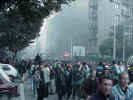|

of the Belgrade Coup
Editor & Webmaster
Leon Chame - 2008
Yugoslav Associates:
- Zoran Radojicic
- Dejan Vukelic
- George Orwell
Contributing Websites:
- Original Sorces
- Transnational (TFF)
- Fair sources
- WSWS
avgust 20, 2008
| |
War: A few words about tactics
Much to NATO’s regret, the news of Yugoslav air defenses’
death was somewhat exaggerated. There can be no reasonable doubt
that NATO lost several dozen aircraft and continues to lose both planes and personnel in
attempts to suppress Yugoslavia’s formidable network of air defenses. Prior to
the conflict, several major Western news agencies reviewed Yugoslavia’s air defense
capabilities and many military experts agreed that NATO will be certain to encounter
fierce resistance. Several days before the aggression begun, Pentagon’s official
estimates showed that NATO expected to lose at least twelve aircraft in the first days of
war, until they neutralize Yugoslavia’s air defenses. In
several public presentations for the world media, NATO laid out a comprehensive,
multistage plan, the first stage
of which called for neutralization of Yugoslavia’s air defenses. Several weeks into the conflict NATO was forced to scrap this plan.
After a press conference, during which NATO officials announced that they are comfortable
with the way Yugoslav air defenses were suppressed, the unthinkable happened: United
States Air Force lost one of its F-117A stealth bombers not far from Yugoslavia’s
capital of Belgrade. This was the only loss admitted by NATO and only after the burning
remains of the aircraft were shown on television worldwide. Since
then, NATO decided to go ahead with the second phase of its
campaign - low-level, low-speed attacks on Yugoslav army
forces in Kosovo - even though the objectives of the first phase were far from being
achieved. This extraordinary step by NATO command highlighted significant flaws in
its original planning and military experts worldwide feared increasing losses among NATO
aircraft.
To answer the question of why Yugoslavia’s
air defenses were not suppressed, it would be a good idea to consider its strengths.
A brief look at Yugoslavia’s air defense arsenal reveals one such important strength
- diversity of weapons: Yugoslavia has anti-aircraft weapons of all shapes and sizes. Even
though Serbs may lack the latest, most sophisticated SAM systems (a gap hopefully to be
soon filled by Russia’s advanced S-300 SAM system), the systems they have are capable
of defending Yugoslavia against any number of aircraft and any tactics employed by the
enemy and especially against NATO approach of limited warfare. Perhaps the most important
advantage of Yugoslav air defenses are its mobile assets - SAMs, AAA, and radars. It is
known that Yugoslav military commanders expected that most of their stationary radars will
be hit by NATO aircraft in the early days of the campaign: even if these radar are not
being used, their locations are well-known to NATO. This is exactly what happened, in the
first few days of air strikes, NATO aircraft and cruise missiles targeted Yugoslavia
stationary radar installations and known stationary SAM sites. It would be reasonable to
assume that most of such installations, locations of which were known to NATO planners,
were heavily damaged or destroyed. However, this is where NATO’s success abruptly
ended. Now NATO pilots were faced with a difficult task of tracking down Yugoslavia’s
mobile radars, SAMs, and AAA systems. Yugoslav mobile radar are used for a very limited
period of time, following which they are disengaged and relocated. This tactics may not
provide Yugoslavia with around-the-clock, integrated air defenses, but seems sufficient to
significantly hamper NATO's efforts.
Not hoping to destroy the mobile air defenses, NATO made emphasis on
electronic suppression: scores of additional electronic warfare aircraft were deployed
from the US to Yugoslavia. These efforts did not prove to be
successful as was hoped, in larger part because Yugoslavia’s military commanders
skillfully managed their mobile air defense assets and used older radars as decoys to
distract a significant portion of NATO’s resources. In addition to these
difficulties, NATO had to restrict its aircraft primarily to high-altitude missions in
order to avoid Yugoslavia’s innumerable mobile AAA batteries and man-portable SAMs.
This made targeting of Yugoslav mobile military equipment extremely difficult. Another major complication NATO encountered, was its inability to
establish real-time surveillance and targeting via its fleet of reconnaissance aircraft,
including a number of UAVs. Yugoslav air defenses were successful in destroying a
number of US and German UAVs operating over its territory, these included an American
Hunter UAV, of which the US had only seven. One month into the campaign and NATO managed
to hit only a handful of Yugoslavia’s mobile military targets, including several
tanks, APCs and aircraft. It became clear to NATO command that
continuing with the second phase of the aggression was hopeless. Early in the war a
Russian military expert estimated NATO's effectiveness against targets in Yugoslavia at
only 15-20% and he said that NATO first and second phases of the aggression will fail. He
was right. A new strategy was developed.
NATO begun targeting Yugoslavia’s
infrastructure - oil refineries, manufacturing facilities, power stations, major bridges,
and a number of other civilian targets - hoping mainly to
raise fear among Yugoslav public and, to a lesser degree, to
disrupt a flow of fuel, ammo and other supplies to Yugoslav forces in Kosovo and
elsewhere. Once again, this new strategy backfired: psychological effect of the
strikes on Yugoslav public was contrary to what was expected by NATO, and affecting
country's infrastructure through selective bombing campaign was an exceptionally long-term
strategy, allowing Yugoslav military sufficient time to adapt. Yugoslavia was able to
successfully protect its military aircraft by using an extensive network of well-designed
shelters. Yugoslavia’s two largest airbases of Slatina and Batanjaca were hit hard by
NATO bombs and missiles, however, these and other airbases are equipped with aircraft
shelters capable of absorbing even nuclear blasts. Runways at Yugoslav airbases were
heavily damaged by NATO bombs, however, Yugoslavia has methods and technology allowing it
to repair damaged runways in under an hour. NATO claimed that it has destroyed around six
Yugoslav MiG-29 fighter aircraft, however, NATO was able to document
the destruction of only two MiG-29s: one over Yugoslavia by a Dutch F-16 fighter and one
over Bosnia by SFOR troops. According to the statements from NATO’s press
service, several Yugoslav aircraft were hit on the runways, however, it is known for a
fact that all Yugoslav aircraft were secured in shelters well before the campaign started.
It is also known that Yugoslavia’s air force was quite inactive, limiting its
activities to occasional harassing of NATO bombers and hunting for cruise missiles,
although there was some significant Yugoslav air force activity near Pristina.
NATO does not have air supremacy over Yugoslavia.
Resilience of Yugoslavia’s air defenses forced NATO to adopt an unusual tactics: NATO
aircraft gather in large numbers outside of Yugoslavia’s borders and commence
simultaneous but brief attacks against a limited number of pre-determined, mainly
stationary civilian targets. This tactics is all about minimizing possible losses even if
it means minimizing the effectiveness of strikes. Bombing of Yugoslavia’s fuel
facilities was a priority for NATO aircraft in the recent days. NATO estimates that the
remaining fuel will last Yugoslavia up to three months, while more realistic estimates
suggest that there is enough fuel to last Yugoslav armed forces for as long as two years.
Even though NATO claimed to have destroyed up to 70% of Yugoslavia’s oil and
related facilities, the country’s military is unlikely to run out of fuel.
Venik
|


